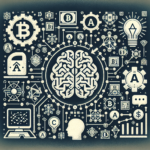The Intersection of Blockchain and AI
Understanding Blockchain Technology
Blockchain is a decentralized digital ledger that records transactions across multiple computers in such a way that the registered transactions cannot be altered retroactively. This technology ensures transparency and security, making it highly valuable for various applications, especially in finance. Each block in the chain contains a number of transactions, and once a block is filled, it gets added to the chain in a linear, chronological order.
Basics of Artificial Intelligence
Artificial Intelligence (AI) refers to the simulation of human intelligence in machines programmed to think and learn like humans. AI encompasses a variety of subfields, including machine learning, natural language processing, and robotics. In the financial sector, AI analyzes large datasets to make predictions, automate tasks, and enhance decision-making processes.
Collaborative Innovations in Finance
How Blockchain Enhances Financial Transactions
Blockchain technology revolutionizes the way we think about financial transactions. Traditional banking systems often involve lengthy processes with multiple intermediaries, leading to delays and increased costs. Blockchain, on the other hand, streamlines these processes by enabling peer-to-peer transactions without the need for intermediaries.
For instance, cross-border payments can be made almost instantly with lower transaction fees. This is particularly advantageous for individuals in developing countries who might rely on remittances from abroad, giving them faster access to funds that can uplift their economic status.
The Role of AI in Fraud Detection
Fraud remains a significant challenge for financial institutions, with losses climbing to billions of dollars annually. AI plays a crucial role in identifying and mitigating fraud through advanced analytics. Machine learning algorithms can analyze historical transaction patterns and flag anomalies that indicate fraudulent activity.
This application not only helps in detecting fraud but also enhances customer trust in financial systems. When customers know that their transactions are monitored intelligently, they feel more secure about participating in financial systems.
Financial Inclusion through Technology
Defining Financial Inclusion
Financial inclusion refers to the accessibility of financial services for all individuals, regardless of their socio-economic status. It aims to provide affordable, easy access to savings accounts, credit, insurance, and other financial services. The need for financial inclusion is especially urgent in regions where traditional banking infrastructure is lacking.
The Combined Power of Blockchain and AI for Inclusion
The combination of blockchain and AI offers innovative solutions to enhance financial inclusion. These technologies can create a more inclusive financial ecosystem by offering alternative solutions to underserved populations.
Microfinance and Smart Contracts
Microfinance institutions (MFIs) aim to provide financial services to low-income individuals, but operational challenges often hinder their effectiveness. Blockchain can introduce smart contracts that automate lending processes, making it easier for MFIs to disburse and collect loans.
For example, smart contracts can automatically trigger repayments once a borrower receives their income, reducing default rates and improving financial health for individuals who may struggle to make regular payments. With AI analyzing the data, these institutions can better assess creditworthiness, even for those without traditional credit histories.
Decentralized Identity Verification
One major barrier to financial inclusion is the lack of identity verification for unbanked populations. Blockchain technology allows for the creation of secure, decentralized digital identities. These identities can be utilized to access various financial services without compromising user privacy.
AI can enhance this process by verifying identities through facial recognition and biometric data, making it much simpler for individuals in remote areas to gain access to necessary services. This can significantly expand the customer base for financial institutions while promoting inclusion.
Challenges and Considerations
Regulatory Hurdles
Despite the potential of blockchain and AI, regulatory challenges still pose a significant barrier to implementation. Governments and financial institutions must navigate complex legal landscapes, ensuring compliance with existing regulations. This is particularly important in sectors involving personal data and financial transactions.
Cosmetic solutions may not be enough; comprehensive regulatory frameworks are necessary to facilitate the use of these technologies effectively. Policymakers must work to understand the technology and address potential risks while still fostering innovation.
Technological Accessibility
While blockchain and AI have transformative potential, it’s vital to consider the technological readiness of the target populations. Individuals in remote or impoverished areas may not have access to smartphones, stable internet, or the necessary knowledge to use these tools effectively.
Education and resources must be invested to ensure that these technologies can be utilized by everyone, not just those already familiar with digital financial systems. Partnerships between tech companies, NGOs, and local governments could provide the required training and infrastructure.
Case Studies of Blockchain and AI in Action
Successful Implementations
Let’s take a closer look at some initiatives where blockchain and AI have successfully worked together to promote financial inclusion.
Provenance and Supply Chain Financing
Provenance is a platform that uses blockchain technology to improve the transparency of supply chains. By providing consumers with information about the origins of their products, it allows small producers to access larger markets. AI algorithms analyze market trends to predict demand, giving producers the insights they need to thrive.
BanQu and Digital Identity
BanQu focuses on providing digital identities to those without formal identification in developing countries. Using blockchain, they create immutable records that can be accessed by governments and financial institutions. AI enhances this by verifying identities securely, paving the way for individuals to gain access to vital services.
Future Prospects
Looking ahead, the combination of blockchain and AI holds immense promise for transforming financial systems. As technology progresses and regulatory frameworks adapt, we may see a new era of inclusive finance that empowers individuals worldwide. Moreover, ongoing collaborations between tech innovators, financial institutions, and governments will be essential in addressing the challenges and unlocking the full potential of these technologies.
By harnessing the collaborative innovations of blockchain and AI, we can work towards a future where financial inclusion is not just a goal but a reality for everyone, helping to create equitable opportunities and drive economic growth on a global scale.








